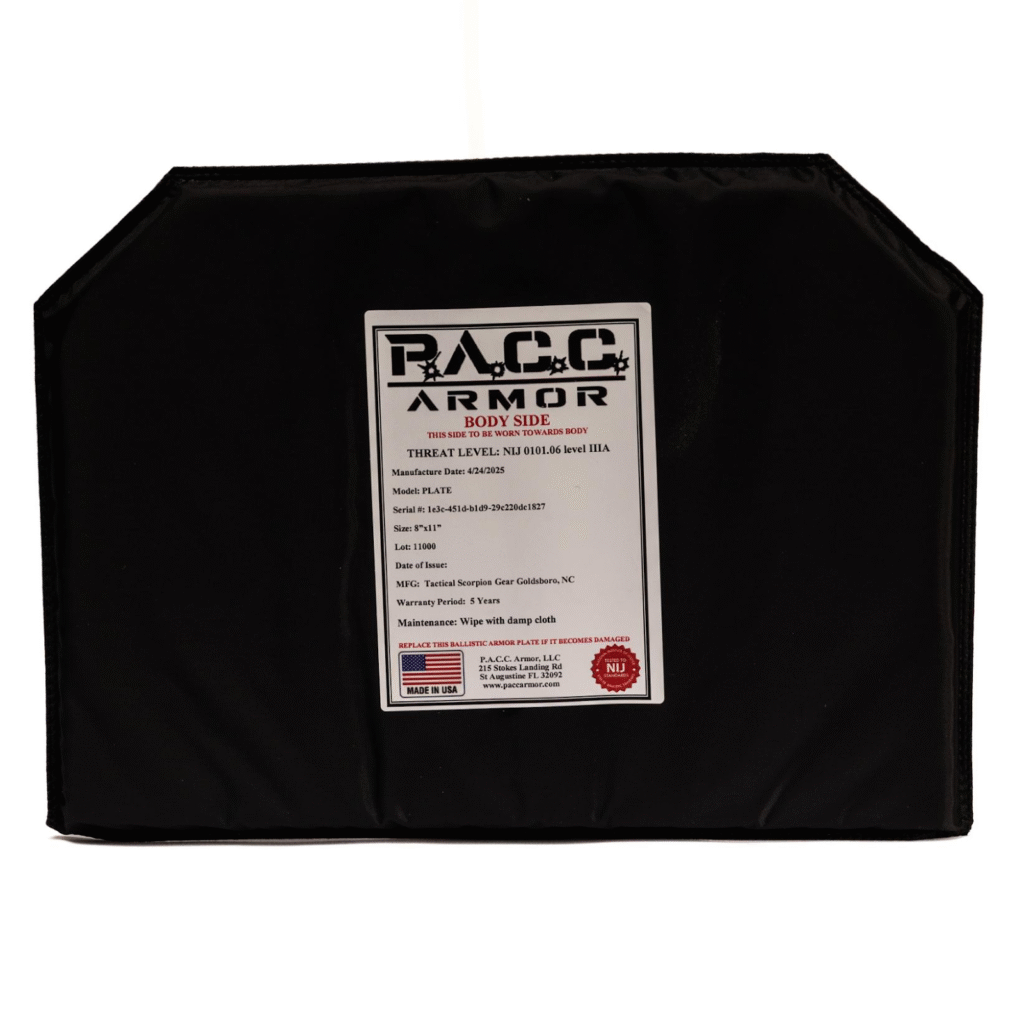Twenty years ago, body armor meant one thing: those huge tactical vests police wore. Bulky. Obvious. Hot as hell. PACC Armor threw that playbook out the window. They’re making armor plates for people who actually need to blend in, professionals who can’t walk around looking like SWAT team members but still face real threats. This isn’t surplus military gear with a new sticker. It’s protection built from scratch for folks whose biggest tactical concern is not looking tactical at all.
Here’s what changed. Regular people started realizing that bad things happen to good people. Active shooters don’t check your job title first. Home invasions hit nice neighborhoods too. Suddenly, teachers, doctors, and business owners wanted protection options. But they couldn’t show up to work wearing military gear. They needed something different.
The problem? Most armor falls into two camps. Either it stops handguns but fails against rifles, or it handles rifles but weighs a ton. Like choosing between a raincoat and a winter parka, great for specific conditions, useless for everything else. Smart protection means matching armor to actual risks, not worst-case fantasies from action movies.
The Science Behind Modern Armor Technology
Let’s get nerdy for a minute. When bullets hit armor, physics takes over. Energy has to go somewhere. Good armor spreads that energy out, like catching a baseball with a mitt instead of your face. Ceramic plates? They shatter on purpose, breaking the bullet apart. Soft armor works differently, special fibers grab projectiles and stretch, spreading impact forces across a bigger area.
The government, specifically the National Institute of Justice, tests all this stuff. They shoot plates with specific rounds at exact speeds. Pass the test, get certified. Fail, and you’re just selling expensive placebo protection. These NIJ ratings matter because marketing departments lie but physics doesn’t. When a plate says it stops certain threats, NIJ certification means it actually does.
New testing standards dropped recently. The 0101.07 update makes tests harder and ratings clearer. Good news for buyers, less confusion about what you’re getting. Bad news for companies selling garbage plates with creative marketing. These standards help regular people understand what they’re buying without needing a ballistics degree.
RF2 Ceramic Hard Armor: Next-Generation Rifle Protection
OK, so RF2 sounds like a robot name. It’s actually “Rifle Fire level 2” under the new standards. This rating focuses on one nasty round, the M855, aka “green tip” ammo. Why care about green tips? They’re everywhere. Cheap, common, and they punch through stuff that stops regular bullets. That steel core inside doesn’t play nice.
PACC’s RF2 ceramic plates handle green tips like a champ. See, M855 rounds were designed to penetrate barriers. Car doors, walls, whatever’s between soldiers and targets. That 62-grain steel-core bullet zips through materials that might stop conventional rounds. Regular soft armor? Forget it. Might as well wear a t-shirt. Even some older hard plates struggle with M855 penetration.
Ceramic armor tech is wild. Bullet hits, ceramic shatters, but that’s the point. The breaking ceramic disrupts the bullet’s path while eating up energy. Think of it like a cue ball hitting racked pool balls. All that forward energy spreads out in different directions. Modern ceramics use space-age materials that maximize this effect while staying relatively light. Sure, they’re heavier than soft armor. But way lighter than steel plates grandpa wore.
What’s this mean for normal people? If rifles concern you, maybe you work somewhere rural, or active shooter risks keep you up at night, RF2 plates provide legit protection. They fit in low-profile carriers that don’t scream “tactical.” Weight stays manageable for all-day wear if needed. And unlike single-use protection, quality RF2 plates handle multiple hits. Because bad guys rarely shoot just once.
Real talk: most people don’t need rifle protection daily. But for those who do, RF2 represents the sweet spot. Effective against common rifle threats without requiring a forklift to move. That’s progress.
3A Soft Armor: The Handgun Protection Standard
Statistics time: handguns cause most firearm injuries. Rifles grab headlines, handguns do damage. That’s why Level 3A soft armor sells like crazy. It stops virtually every pistol round you’ll encounter while staying flexible enough to actually wear.
The testing gets specific. Level 3A must stop .357 SIG rounds hauling ass at 1,470 feet per second. Also needs to handle .44 Magnum at 1,430 fps. Those are screaming-fast handgun rounds with serious penetration power. If armor stops those, it’ll handle the common stuff, 9mm, .40 cal, .38 special, whatever.
Soft armor uses synthetic fibers stronger than steel when you compare weight. Aramids, polyethylene, materials that sound fake but work great. Bullets hit these fiber layers and get tangled up like a bird in a net. The fibers stretch and deform, spreading impact energy across a wider area. No penetration, less blunt trauma. Science is cool.
Here’s why soft armor rocks for daily use. It bends. Flexes. Moves with your body instead of fighting it. Hard plates feel like wearing a cutting board. Soft armor feels more like a thick jacket. For office workers, medical staff, anyone who needs protection without looking protected, Level 3A provides the answer.
The comfort factor can’t be overstated. Armor you won’t wear protects nothing. Level 3A’s flexibility means people actually use it. All day if needed. Under dress shirts. In carriers that look like computer bags. Protection that works with your life instead of dominating it.
Integration and Practical Application
Best armor ever made means squat if it lives in your closet. PACC figured this out. Their plates work in carriers that look totally normal. Laptop bag? Check. Messenger bag? Yup. Nobody needs to know you’re carrying armor until you need it.
Mix and match based on reality, not paranoia. Office job downtown? Level 3A soft armor probably covers you. Working security at special events? Maybe RF2 plates make sense. Rural property where hunting accidents happen? Rifle protection seems smart. Point is, pick protection matching your actual risks.
Think about deployment speed too. Threats don’t wait for you to suit up. Good carriers let you go from carrying to wearing in seconds. Unzip, throw on, you’re protected. This isn’t mall ninja stuff, it’s practical planning for imperfect situations. Having armor nearby beats having perfect armor at home.
Storage matters. These systems stage easily in offices, vehicles, homes. Slide a carrier under your desk. Keep one in the truck. Have another by the bed. When designed right, armor integrates into life seamlessly. No gun safes needed. No special equipment rooms. Just sensible placement of life-saving gear.
Making Informed Protection Decisions
Buying armor without honest assessment wastes money and maybe worse. City living presents different risks than country life. Desk jobs differ from field work. Be real about your situation. That determines what protection makes sense.
Physical reality check: armor adds weight. Even “lightweight” plates weigh something. Can you wear it for hours? All day? While running? Be honest or you’ll own expensive wall decorations. Start lighter and upgrade if needed. Better to wear Level 3A regularly than own RF2 plates you never use.
Cost enters the equation too. Quality armor ain’t cheap. But neither are emergency room visits. Or funerals. View it like insurance, hoping you’ll never need it while being glad it’s there. Budget for good stuff. Cheap armor fails when needed most.
Don’t forget training. Armor changes how you move. Alters balance. Affects stamina. Practice wearing it during normal activities. Hit the gym with plates on occasionally. Take some tactical classes if you’re serious. Familiarity under stress saves lives. YouTube doesn’t count as training.
Embracing Prepared Protection
We’ve reached a weird point where civilian armor matches military gear from Desert Storm. RF2 plates stop threats that required tank armor back then. Level 3A soft protection fits under polo shirts. Wild times, but here we are.
PACC Armor gets the assignment. Protection shouldn’t require tactical cosplay. Their gear works for actual professionals living actual lives. Quality manufacturing means trusting your life to their products, literally. They understand different people face different threats. One size fits nobody.
Time to stop pretending bad things only happen to other people. They happen to teachers. Nurses. Store managers. Regular folks going about regular days until suddenly they aren’t. Being prepared isn’t paranoid anymore. It’s practical.
Check out PACC Armor’s full lineup. Talk to their people about what makes sense for YOUR situation. Not some generic threat matrix. Your life, your risks, your protection needs. They’ll guide without overselling because reputation beats quick sales.
Visit their site. Send an email. Make a call. Ask the uncomfortable questions about what threats keep you awake. Whether that’s handguns requiring Level 3A or rifles demanding RF2 ceramic, they’ve got answers backed by NIJ testing and real-world use. Don’t wait for bad news to wish you’d prepared. Reach out to PACC Armor now. Because hope isn’t a strategy, but preparation can be invisible until needed. That’s the protection modern life demands, ready when it matters, unnoticed when it doesn’t.




